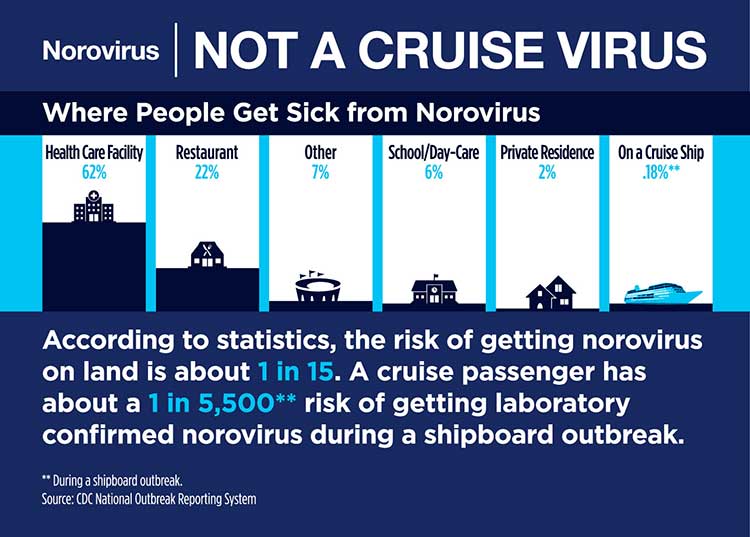Table Of Content

Wherever there are large groups of people, there is the potential for any contagious disease to spread. This is true on cruise ships, and different outbreaks of norovirus, influenza, coronaviruses, salmonella, rhinoviruses, and other quick-spreading diseases do occasionally happen among cruise ships passengers and crew. CDC requests that cruise ships submit a cumulative ARI report (even if no ARI cases have occurred) preferably within 24 hours before arrival in the U.S. [7], and sooner if a voyage’s crew or passenger ARI attack rate reaches 3% [8]. These reports are requested by completing the Cruise Ship Cumulative Acute Respiratory Illness (ARI) Reporting Form.
Recommendations when a voyage’s crew or passenger ARI attack rate reaches 2%‡
A staff member may ask you additional questions, and you might be sent for secondary screening by a doctor. Should they determine that your or anyone else’s health would be jeopardized, they may not let you board. Everyone—including fellow passengers and crew—wants you to be healthy on your cruise.
Why are acute gastrointestinal illnesses including noroviruses associated with cruise ships?
How to Avoid Getting Sick on Your Next Cruise - Thrillist
How to Avoid Getting Sick on Your Next Cruise.
Posted: Thu, 29 Feb 2024 08:00:00 GMT [source]
Coast guard helicopter teams fly to the ship, hoist the passenger (accompanied by a spouse/relative and a crew nurse) and fly them to the nearest land hospital. VSP (abbrev "Vessel Sanitation Program") monitors CDC's observations on illness patterns for GI (gastrointestinal) outbreaks on passenger shipping vessels (ferries and cruise ships). Norovirus on ships is spread through contaminated water, foods and surfaces (public restrooms, railings, doorknobs, handles, board games-cards-puzzles-toys, etc). Norovirus withstands chlorine, prolonged exposure outside the body, as well as temperature extremes.
Outbreak Updates for International Cruise Ships
No one is suggesting not using the handrail on a staircase, but get in the habit of pushing the elevator button with your elbow and not putting your hands on the bar when you order a drink. And just FYI, if you’re sharing these things that germ experts wouldn’t share, you’re putting yourself at an increased risk of getting sick. Cruise lines’ crew work hard to keep everything clean to minimize the spread of communicable diseases, but it’s up to you to be cautious as well. The Norwegian Dawn has more than 2,100 passengers and 1,000 crew on board. About 2,000 of those travelers were set to complete their journey on Sunday by disembarking in Mauritius, in the Indian Ocean just east of Madagascar, the Ports Authority said.
It's important to wash your hands with soap and clean water frequently, but especially after using the bathroom or changing diapers, before eating and before touching your face. “Norovirus is one of the few viruses that doesn’t get deactivated by alcohol. You actually need to use soap and water to physically destroy it and remove it from your hands,” Ostrosky previously told TODAY.com. Exposure to less than 100 norovirus particles can make someone sick, and infected people typically shed billions of particles, according to the CDC.
Get our newsletter

Some of the world's most famous passenger ships are listed in the virus outbreak statistics, yet one hears so little of it in mass media news. And there is no surprise in that since the "cruise illness" news are nothing but bad publicity for the companies - which is bad for a prosperous multi-billion dollar sea travel vacation business. All major cruise line companies will do their best to keep quiet about virus outbreaks on their ships. There are passenger testimonials about quarantined ships and how badly guests have been treated by the line.
Diseases on Cruise Ships – Why We Hear About Them More
One to keep an eye on is shigella, which the CDC notes has been behind GI outbreaks on cruise ships. This bacterium causes an infection known as shigellosis, which can cause fever, stomach pain and diarrhea that can be bloody or prolonged. Before COVID-19, colds and other minor respiratory illnesses were not taken as seriously as they are now.
How much does it cost to see the doctor on a cruise ship?
For more information, read updated resources for clinicians and guidance on the medical evaluation and management of people with COVID-19, influenza, or RSV are available on CDC’s websites. [4] Back-to-back sailing refers to passengers who stay on board for two or more voyages. Royal Caribbean Group's eradication program is certainly a positive step, but if you're still worried about catching norovirus, the risks are low. Norovirus is referred to as "the stomach flu", and is easily spread from person to person. Land-based operations ("Field Service") include mobile clinics providing screening for potential surgery patients, healthcare, dental care, also mental health programs, infrastructure projects.
It takes about 30 sec of hard rubbing with hot water and soap (including under the nails) to wash it. The cruise line “immediately activated their enhanced health and safety protocols to ensure the well being of all guests and crew on board and these measures have been effective,” the company said. By taking steps to protect yourself from illness, you minimize your risk of getting sick on a cruise vacation and you can enjoy every moment of your oceangoing getaway. If you do get sick, seek medical attention, particularly for severe symptoms that may indicate a more serious ailment.
Coast Guard (or equivalent officials in other countries) are available to them, which can provide a helicopter evacuation, or by boat if they are closer to shore. When Jennifer Lautenschlager woke up with sniffles and a headache last month, she canceled her plans and went to see the doctor. The nurse took her temperature – she had about a 102-degree fever – and ran some tests, and the doctor examined her, before sending her on her way with several prescriptions. An MSC Cruises representative told Insider at the time that the cruise line had launched an internal investigation based on the inspector's concerns and taken immediate corrective actions. Get Reader’s Digest’s Read Up newsletter for more travel, cleaning, humor, tech and fun facts all week long.
Cabins are cleaned once a day, and other common areas, such as elevators and pools, are cleaned multiple times a day. Close living quarters, shared bathrooms, populated pools, busy buffet lines and rapid turnover of passengers make it difficult to control the spread of the virus once it hits a ship. “It’s just really the perfect scenario for transmission of highly contagious GI [gastrointestinal] pathogens,” Lucar says. Scott said how cruise ships get sick or injured passengers to shore depends in large part on "the weather, the location and the assets available."
Similar travel warnings were issued by other health agencies and governments. Generally, Zika is a mosquito-borne virus spread by Aedes aegypti (aka "yellow fever mosquito") and Aedes albopictus (aka "Asian tiger mosquito"). However, it became "cruise virus" since the decease can also result from intrauterine (contraceptive device), sexual intercourse, blood transfusion, lab exposure, organ/tissue transplantation, breast milk transmission. Numerous studies confirm that a quick application of hand sanitizer doesn't kill the Norovirus.
Norovirus Outbreaks Surge on Cruises: Here's How to Avoid the Bug - TODAY
Norovirus Outbreaks Surge on Cruises: Here's How to Avoid the Bug.
Posted: Thu, 13 Jul 2023 07:00:00 GMT [source]
Therefore, it’s impossible to report whether or not all of those travelers were part of an outbreak on the aircraft. Hepatitis A is yet another common virus transmitted in contaminated food, water, or fecal matter. Symptoms first appear flu-like, but left untreated, the virus can lead to severe liver damage. Food and water can be contaminated when people who handle food do not properly wash their hands after using bathrooms. The International Association for Medical Assistance to Travellers (IAMAT) has prepared a summary on how to stay healthy on a cruise.

No comments:
Post a Comment